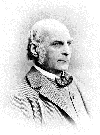
Galton appears to have spent his early years living the comfortable life of an English gentleman, his inheritance freeing him from the necessity of work. However, by 1849 he appears to have tired of this and began a career as a scientist. Initially his contributions were in geograhpy, where he became heavily engaged with the Royal Society, including drafting the instructions for Livingstone and Stanley's expedition to find the soure of the Nile.
In 1859 Galton's cousin Charles Darwin wrote Origin of the Species, a book that was to have a profound influence of Galton's career. Galton immediately became one of the leading proponents of Darwin's theories, in particular applying theories of heredity to talents such as intelligence. Galton's book Hereditary Genius posited that genius was an hereditary trait, something even Darwin did not believe until reading Galton's book. He was the first to use surveys and questionaires in studying groups of people.
Galton gathered enromous amounts of data on human differences, especially from generation to generation. This data led him to discover that the offspring of taller parents tended to be shorter, i.e. closer to average in height. Similarly the offspringer of shorter parents tended to be taller Galton called this tendency "regression." His pioneering contributions to the theories of correlation and regression set the stage for Pearson and others to lay the foundations of biostatistics. That Galton did not understand the complexities of correlation when more than two variables were involved does not detract from his initial contributions. However, Galton misunderstood far more than just multivariate mathematics.
Galton believed that by studying human differences he could identify those individual and racial characteristics that were beneficial and detrimental and became an advocate for using government power to improve humanity -- and to preserve"superior" racial types. In the US these ideas came to have great currency; forced sterilization laws for the "feeble minded" and various "degenerate": classes were passed first in 1907 in Indiana and eventually in 30 other state states. The US Supreme Court held these laws were constitutional, with Oliver Wendel Holmes writing for the 8-1 majority in 1927 in Buck vs. Bell
"It is better for the world, if instead of waiting to execute offspring for crime, or to let them starve for their imbecility, society can prevent those who are manifestly unfit from continuing their kind. The principle that sustains compulsory vaccination is broad enough to cover cutting the Fallopian tubes. "
Unsurprisingly, the "degenerate" classes came to include many socially disfavored groups, with racial and homophobic bias often playing a role in determining who should be sterilized. (Given that the goal of sterilization was to prevent procreation, exactly why gay people should have been sterilized was never made clear--see the Alan Turing biography for one disgraceful example in the UK.) Over 50,000 Americans were sterilized under these laws.
Unsurprisingly, lawyers defending Nazi war criminals -- who acted on the same flawed eugenics premises -- quoted US laws and Supreme Court decisions at the Nuremburg Trials.
Mainstream biological scientists, including the co-discoverer of evolution Alfred Russell Wallace, did not accept Galton's explicitly racist views. While Galton viewed variance from his "normative" values as "deviation," subsequently scientists have used Galton's discovery of regression as evidence of the natural and healthy variation and diversity in human populations. Today Galton's eugenics theories have been fully discredited scientifically. Stripped of flawed cultural biases, biometrics is today fundamental to our understing of many public health and medical issues.
While Galton's eugenics theories had horrific consequences, most notably in Nazi German but also in the US, it should be noted that these ideas were in the mainstream of European thought at the time. In many ways Galtons' ideas were simply a continuation of the "moral statistics" of Quetelet, for example, and culminated in the US and the UK in the philosophical "Social Darwinism" of Herbert Spenser that continues to have great currency in certain circles in the US. That there is no scientific evidence supporting these notions does not seem to reduce their cultural and political resonance.
On a more positive note, among the data that Galton gathered, analyzed and classified were the loops and whorls on human fingers, proving that these remain stable over a person's lifetime. With Si r Edward Henry he developed the scheme for classification of fingerprints which by 1901 was in world-wide use and is still in use today.
Galton was also a pioneer in meteorology and published the first weather map that included atmospheric pressure. He was knighted in 1909. The website Galton.org contains more information on this important but flawed statistician.
Born: 16 Feb 1822 in Sparkbrook (near Birmingham), England
Died: 17 Jan 1911 in Grayshott House, Haslemere, Surrey, England
The premiere site for biographies of mathematicians on the web is at The University of Saint Andrews in Scotland; this is the primary source of the information in these short biographies. Some biographies used additional web resources as noted in the biography.
The postage stamp images came from a wonderful site on mathematicians on stamps maintained by Jeff Miller, a mathematics teacher in Florida.
The Free Internet Encyclopedia Wikipedia is also an excellent source of information and was used as a reference for many bographies.
The opinions expressed in these biographies are those of the author and do not reflect official views of the University of Oklahoma.
